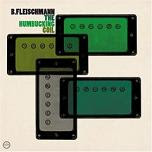Best in Music: February 2006 Edition
 B. Fleischmann – The Humbucking Coil (Morr Music)
B. Fleischmann – The Humbucking Coil (Morr Music) Morr Music has been a breeding station for indie electronic since its genesis back in ’91. The German label can be hold accountable for introducing countless musicians who create synthetic emotions with ambient instrumentals over perpetual drum loops. B. “for Bernard” Fleischmann’s second solo creation, The Humbucking Coil, is the latest Morr representative to flourish. The album possessing Morr’s trademark sound is not surprising but, as the title hints, the key element integrated with the drums looping and the instruments ambienting are clean guitar leads. Familiar components that make the genre a pleasurable listen are still present–oscillating vibraphones, clicking synth percussions, hushed cymbal crashes–so Fleischmann is not accredited for his innovation. However, the bashful guitar textures accepting the role of melody has made Coil somewhat organic and, as a result, amply refreshing. The fusion of instruments generate spellbinding soundscapes that reluctantly vary from track to track; but, like a favorite movie seen a hundred times in which the enjoyment depreciates slightly after every experience, it’s an ideal escape when the mood calls for it. Considering that The Humbucking Coil is fabricated using Fleischmann’s computer, he is more successful at extracting sensations with a machine than most bands that play real instruments.
[Composure | Static Grate | Aldebaran Waltz]
 Belle & Sebastian – The Life Pursuit (Matador)
Belle & Sebastian – The Life Pursuit (Matador)
There was a scene in the movie, High Fidelity, when a shy record-store clerk puts on Belle & Sebastian’s “Seymour Stein” from their third LP, The Boy With The Arab Strap. Then, Jack Black’s obnoxious character enters, rips the tape out, and designates the tune as “sad-bastard” music, while the shy record-store clerk stands deflated. The episode utterly depicts the musician’s joke, classifying Belle & Sebastian as music for introverts and that fans covertly listen at their own risk of ridicule from the Jack Blacks of the world. But, three years after the movie’s release, along came Dear Catastrophe Waitress, which introduces a more gleaming sound and eludes the “quiet is the new loud” theme of B&S of old. But if DCW was a witness to the band shifting gears, they are clearly at full throttle in their seventh studio album, The Life Pursuit. This version of Belle & Sebastian features a multitude of songs with call-and-response vocals, upbeat melody, and addictive hooks. The essence that ties in all Belle & Sebastian releases is Stuart Murdoch’s insightful sketches of characters with traits that ranges from valiant to sardonic. The Life Pursuit is an album that still resides on the “pop” side of the spectrum but, when graded on a bell curve, it gives the Scottish septet (and their insecure fans) a certain muscularity and confidence.
[We Are The Sleepyheads | For The Price Of A Cup Of Tea | Mornington Crescent]
 Kelley Stoltz – Below The Branches (Sub Pop)
Kelley Stoltz – Below The Branches (Sub Pop)
It’s bewildering–and I’m almost envious–that Kelley Stoltz can accomplish this much without leaving his room. The San Franciscan multi-instrumentalist wrote, performed, and recorded his third album, Below The Branches, entirely in his home studio. From the sounds of it, however, it seems as if his home studio is sandwiched between where 60’s idols Brian Wilson and The Beatles was recording their chamber pop classics while Stoltz has ears on both walls, listening intently and taking notes. Branches paragons the summer sound that, four decades ago, was proven to be an antidote for frigid mornings and overcasted skies. And since the parallels are blatant, the album acts more as a homage to his musical influences than a genre copycat. Upon hearing the assortment of lo-fi instruments Stoltz fiddles with, it is safe to say that his dusty ivories are at the forefront, both musically and on the album cover. The mileage he gets from his 88 black-and-white keys is astounding, though. From whimsical stomps to mellow runs, Stoltz demonstrates his piano’s versatility with each track. The vital selling point here, though, was that Below The Branches was conducted effortlessly. Stoltz doesn’t assert his apparent skill set by trying too hard or by overreaching new grounds, and that simplicity is the quintessence of his charm.
[Ever Thought Of Coming Back | Memory Collector | The Sun Comes Through]


Comments